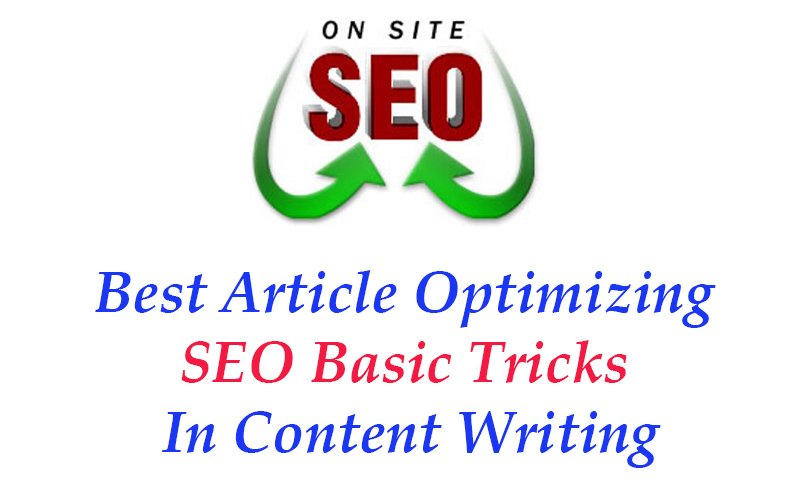
The good news? Anyone can learn these tricks. You don’t need coding knowledge or a marketing degree. With a few smart moves, you can make your content more visible, attract the right readers, and build authority online.
Let’s break it down, step by step, in a way that’s simple, creative, and actually fun.
Why On-Page SEO Still Matters
Search engines are like strict librarians. They don’t just want books on the shelf, they want them organised, labelled, and easy to find. If your content isn’t optimised, it’s like writing a bestseller but hiding it in a dusty basement.
On-page SEO helps your content:
Rank higher in search results
Get clicked more often
Keep readers engaged (longer stay time = better signals to Google)
Earn trust and authority
Without it, even great writing can go unseen. With it, even beginner bloggers can compete with big websites.
What Is SEO Optimization in Content Writing?
SEO optimization in content writing means creating content that’s not just valuable for readers but also easy for search engines to understand. Think of it as a bridge: one side is humans, the other is Google. You’re building a strong, clear path between them.
It includes:
Choosing and placing keywords naturally
Structuring content with headings
Writing clear meta titles and descriptions
Adding links (internal + external)
Making content easy to read and scan
It’s not about tricking Google. It’s about making your content discoverable and useful.
The 3 C’s of SEO Explained
SEO can feel overwhelming, but one framework makes it simple: the 3 C’s of SEO.
Content – Create helpful, original, keyword-smart articles.
Code – Optimise technical elements like meta tags, headings, and alt text.
Connections – Build internal and external links to boost authority.
For beginners, focusing on content + code is the easiest way to see results.
Basic Tricks for On Page Optimization
Here’s where the magic happens. These are the core on-page SEO techniques you can apply to any article.

1. Use Keywords Like Salt, Not Sugar
Your main keyword should appear:
In the title (H1)
In the first 100 words
In one subheading (H2/H3)
Naturally throughout the text
Too much? Google thinks you’re stuffing. Too little? It doesn’t know what your content is about.
2. Headlines & Subheadings Matter
Headings are like signposts for both readers and search engines.
H1 – Use once (the main title).
H2 – Major sections.
H3 – Sub-sections or details.
Example structure:
H1: On Page SEO Basic Tricks
H2: Keyword Placement
H2: Meta Descriptions
H3: Writing Effective Meta Descriptions
3. Meta Titles and Descriptions
Think of this as your ad on Google’s shelf.
Title: Under 65 characters, keyword included.
Description: Around 150 characters, convincing and clear.
Example:
“On Page SEO Tricks: Easy Tips to Rank Higher in 2025.”
4. Internal & External Linking
Links are your content’s connections.
Internal links keep readers on your site (lower bounce rate).
External links to authority sites (Google trusts you more).
Pro tip: Don’t overdo external links. A few quality ones beat dozens of random ones.
5. Optimising Images
Images aren’t just decoration. They can bring traffic too.
Checklist:
Add alt text with keywords (e.g., “on-page-seo-checklist.png”).
Compress file size (faster site speed).
Use descriptive filenames (not IMG123).
6. Content Formatting & Readability
A wall of text scares readers away. Formatting makes it digestible.
Tricks:
Short paragraphs (2–4 lines max)
Bullets or numbered lists
Bold for important words
Tables for comparisons
Table: Bad vs. Good SEO Practices
| Element | Bad SEO Example | Good SEO Example |
|---|---|---|
| Title | “SEO Tricks” | “On Page SEO Basic Tricks for Beginners in 2025” |
| Keyword Usage | Stuffed: SEO SEO SEO everywhere | Natural: keyword appears 5–7 times in a 1500-word post |
| Images | IMG123.jpg, no alt text | “seo-writing-guide.png” with alt text “SEO content writing guide” |
| Meta Description | Missing | “Learn simple SEO writing tricks to boost rankings in 2025.” |
| Internal Links | None | Links to related articles like “Keyword Research Guide” |
Example: On Page Optimization SEO Basic Tricks in Action
Let’s say you’re writing about “Best Shoes for Marathon Training.”
Bad Version
Shoes are important. There are many types. Some are good for running.
Optimised Version
Title: “Best Shoes for Marathon Training – Top Picks for 2025.”
Intro: Mention “marathon training shoes” in first 100 words.
H2: “Why Choosing the Right Running Shoe Matters”
Internal link: “Check our running diet guide for athletes.”
Image alt text: marathon-training-shoes.png
See the difference? The second version is structured, keyword-smart, and reader-friendly.
Free Tools to Help You Do It Smarter
Why struggle when tools can do half the job?
Google Keyword Planner – Find search volume and keyword ideas.
Ubersuggest – Free SEO keyword + content analysis.
Grammarly/Hemingway – Make your writing clean and clear.
Rank Math / Yoast SEO (WordPress plugins) – Real-time SEO checks.
PageSpeed Insights – Improve loading speed.
Step-by-Step SEO Content Writing for Beginners
Here’s your roadmap:
Pick a main keyword (e.g., “On Page SEO tricks”).
Find 2–3 related terms (LSI keywords).
Outline your article with keywords in headings.
Write naturally, keep it engaging.
Add images, internal/external links.
Optimise meta title + description.
Proofread and publish.
Update older posts with these tricks.
Case Study: Optimising a Blog Post in Real Life
Imagine you wrote an article: “Why Blogging Is Fun.”
Before optimization:
Title: “Why Blogging Is Fun”
No meta description
Images named IMG001
No internal links
After optimization:
Title: “Why Blogging Is Fun – 7 Creative Reasons to Start in 2025”
Meta description: “Discover 7 creative reasons blogging is fun and how it helps beginners grow online. Learn SEO tips along the way.”
Images renamed with alt text: blogging-fun-2025.png
Internal link: “Beginner’s Guide to WordPress Setup.”
Traffic doubled in 3 months because search engines could finally understand and recommend the content.
Common Mistakes to Avoid
Keyword stuffing (Google hates it).
Ignoring mobile optimisation.
Forgetting meta descriptions.
Writing only for bots, not humans.
Not updating old posts.
Quick Checklist Before Publishing
Keyword in title, intro, and one heading
Engaging meta description
Short paragraphs + formatting
Internal & external links added
Images optimised with alt text
Call-to-action included
FAQ Section
1. What are the techniques of on-page SEO?
Keyword placement, meta tags, headings, internal linking, image optimisation, and readability formatting.
2. How do I write SEO content writing for beginners?
Start with one keyword, build a simple outline, write naturally, and optimise meta + headings.
3. What are the 3 C’s of SEO?
Content, Code, Connections.
4. Is on-page SEO free?
Yes! With free tools like Google Keyword Planner and Yoast, you can do most things without paying.
5. Do I need to update old blog posts?
Absolutely. Updating posts with fresh keywords and SEO structure can boost rankings faster than writing new content.
Final Thoughts
On-page SEO isn’t rocket science. It’s about helping search engines and readers at the same time. With smart tricks like keyword placement, strong headlines, meta descriptions, links, and optimised images, you can transform average posts into high-performing ones.
Remember: SEO is a marathon, not a sprint. But every article you optimise brings you closer to visibility, authority, and even income.
Pro tip: use a Paraphrasing Tool to refresh old posts. Often, a simple rewrite with SEO basics can outperform a brand-new article.
So, the next time you publish, don’t just hit “Post.” Hit “Optimise.”

Mia Creatives explores the intersection of technology and creativity. Dive into WordPress, SEO, and innovative ways to thrive online.